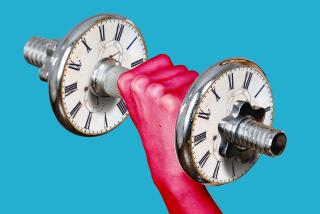Meet the Aging Olympians
Iâm typing this column with a splint taped to my broken finger, a brace encasing my injured wrist, a heating pad across my aching shoulder, an ice pack strapped to my swollen knee . . . and a growing sense of alarm at the notion that this body that has served me so well for years is now in rebellion, turning on me.
So I take some comfort from the realization that Iâm part of a trend; that, according to the American Academy of Orthopedic Surgeons, thousands of baby boomers like me are hobbling through middle age.
Itâs reached epidemic status, they say, this âmini-explosionâ of sports-related injuries afflicting folks in their 40s and 50s.
âEven though we are a sedentary country, thereâs one segment that the message [touting exercise] has hit, and thatâs the baby boomers,â Philadelphia physician Nicholas A. DiNubile told the orthopedists convening in Washington, D.C. two weeks ago.
Thatâs the good news.
The bad news is that, in our quest for physical fitness, we are pushing our bodies to places they are no longer willing or able to go.
Although no one keeps a national tally, doctors say they are treating more exercise-related problems--tears, pulls, strains, fractures--among middle-aged would-be athletes than ever before.
Part of the problem is that we tend to be as fanatical about our exercise regimens--and as impatient for quick results--as we are in so many other areas of our lives. We ignore the painful reality that middle-aged bodies have limitations that younger ones donât: Our muscles are not as elastic, our joints lack the easy lubrication of youth, our recuperative powers are not as strong. We injure more easily and heal more slowly.
And that can conspire to make us feel like we are coming apart at the seams.
Sometimes it seems as if Iâve spent more time in doctorsâ offices in the past two years than I did in the previous 43 years of my life.
Things that used to be easy and fun--a soccer game with my kids, a morning on horseback, a pickup game of basketball--now leave me limping and sore, shuttling between orthopedic specialists, bombarded with physical therapy routines.
And the waiting room at the Southern California Orthopedic Institute in Van Nuys is filled with patients like me. âThey say, âIâm falling apart. Whatâs wrong with me?â Itâs not just the pain but the sense of betrayal they feel,â says Dr. Todd Molnar, an orthopedist specializing in sports medicine and rehabilitation.
Molnar used to reassure his patients: Your bodyâs not conspiring against you. Consider this just an isolated injury.
Then the doctor turned 40, launched his own fitness-comeback routine . . . and wound up limping into work for months.
âI was the classic case,â he said. âLike a lot of my patients, I used to be in great shape. . . . Then I got older, had three kids, gained weight. I stopped running, gave up my gym membership.â
For his 40th birthday, he bought a treadmill and set it up in his bedroom. âBut I pulled my calf muscle on my very first run, so I had to take a week or two off. And as soon as I was able to get back on, I pulled the muscle in the other leg. . . . Then I threw my back out.
âIt took me months to get up to running three miles on a treadmill. And suddenly, I knew what my patients meant. It does feel like youâre falling apart . . . like youâve hit a wall and your bodyâs giving up.â
The problem is most acute for âweekend warriorsâ like me . . . folks whoâve suddenly resurrected or ratcheted up their exercise routines to try to outrun the ravages of age.
But even lifelong jocks and professional athletes are not immune.
At 42, my friend Murad has spent 30 years playing football and basketball every week. He has no intention of letting up, he says.
Still, in the past two months he has broken his nose, fractured his thumb and been hobbled by tendinitis.
Now his athletic routine includes not just weekly football and basketball games but a series of costly and time-consuming investments: Heâs added weight training and running to build strength and resilience; weekly massage and ultrasound to protect his injured tendons and specially designed inserts to cushion his feet. âAnd before each game,â he says, âI stretch like a fiend.
âWe used to take pride in the idea of playing hurt, playing with pain. But Iâve seen too many guys my age go out with serious injuries.â
Now, he says, their mantra has changed: âListen to your body . . . or youâll be on the sidelines, watching the game.â
*
Sandy Banksâ column is published on Sundays and Tuesdays. Her e-mail address is [email protected].
More to Read
Go beyond the scoreboard
Get the latest on L.A.'s teams in the daily Sports Report newsletter.
You may occasionally receive promotional content from the Los Angeles Times.






